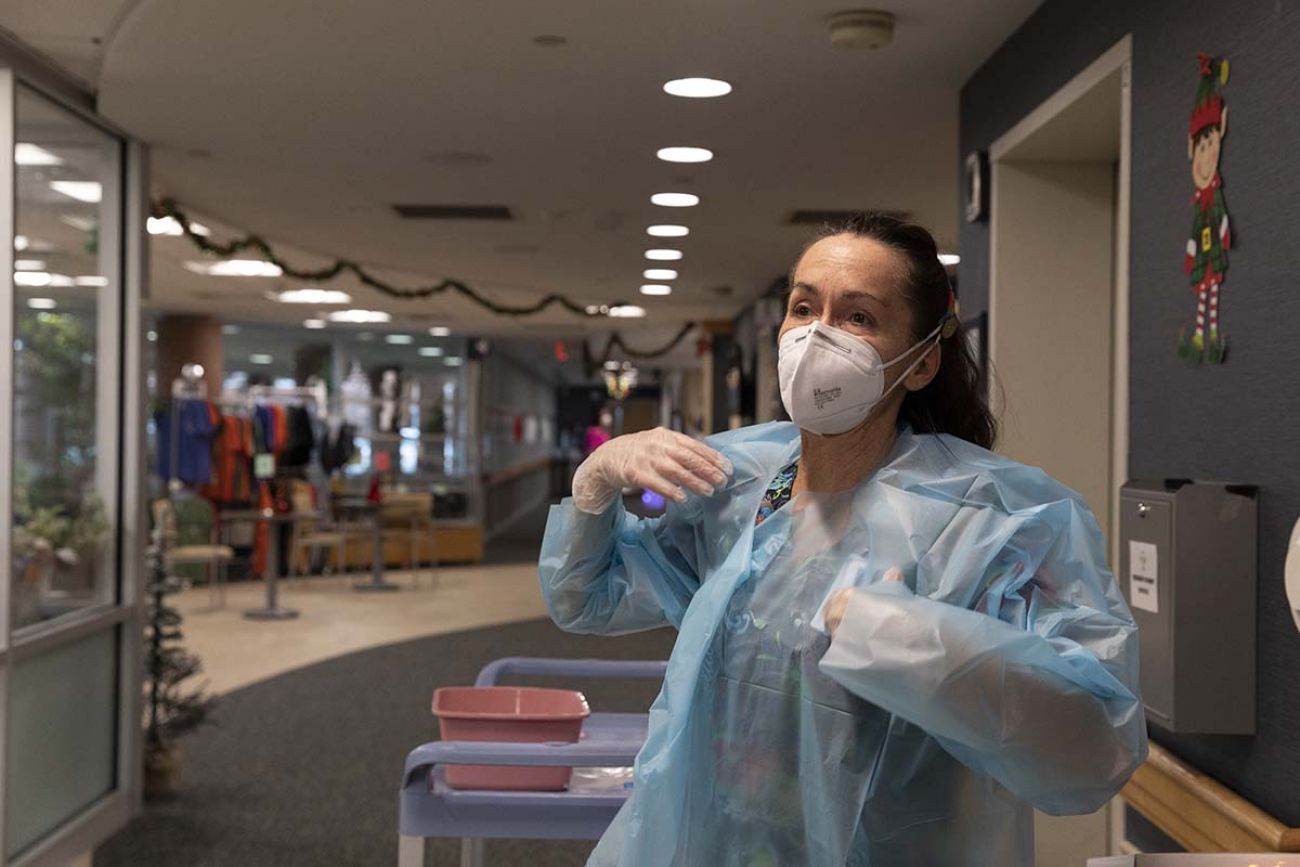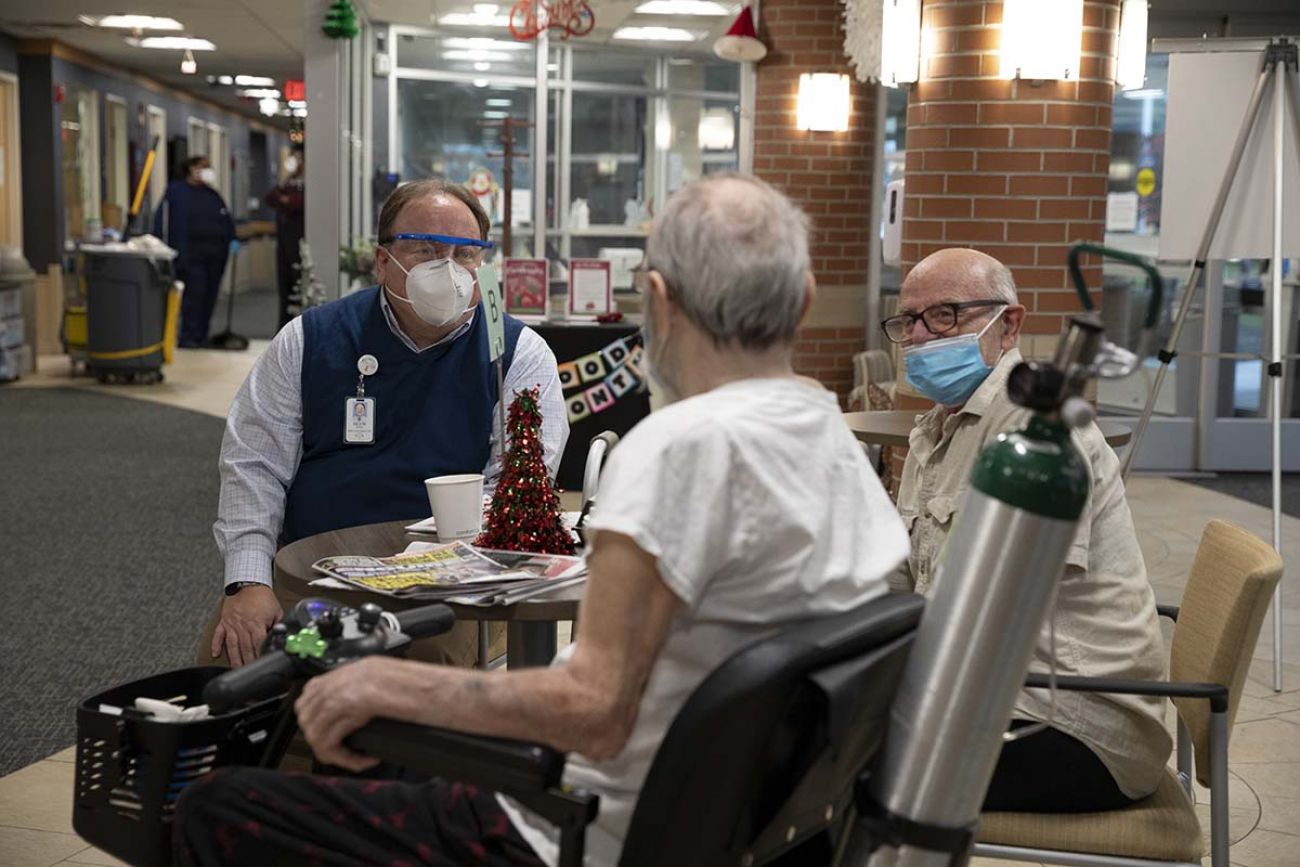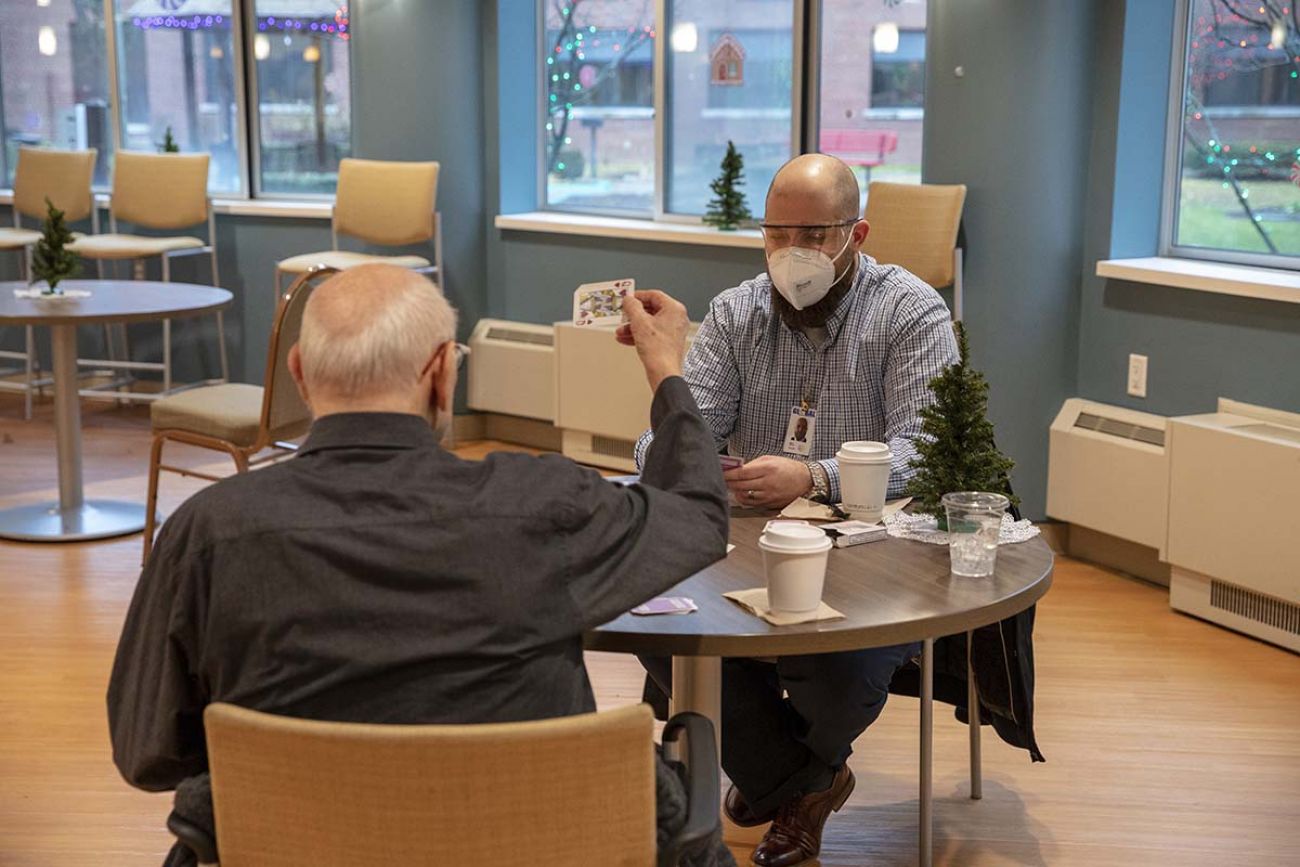Michigan nursing home staff shortage raises peril, adds to hospital woes

MOUNT CLEMENS—The dining room at the Martha T. Berry Medical Care Facility is empty these days. There is no one to staff it.
A few doors down, veteran nurse Nora Kopek administers more than 400 COVID-19 tests a week to residents, staff and guests and vendors — no longer able to tend to the daily intimacy of resident care as she did before the pandemic.
Downstairs in the kitchen, staff last week were preparing a fried chicken meal for lunch and apple dijon pork for dinner — meals that would be offered in the residents’ rooms on paper plates now.
Related:
- How a COVID vaccine rule for nursing home staff could backfire in Michigan
- Amid the isolation of COVID, Michigan Alzheimer’s deaths soar
“We simply can’t provide the meals and wash the dishes, too,” said long-time executive director Kevin Evans, noting that the facility now has 20 open positions, many in the nutrition services department.

The changes at the Berry facility represent a new reality for nursing homes across Michigan as staffing continues to shrink: empty resident rooms, closed wings, delayed building maintenance and, at times, remaining staff who are so consumed with COVID-related tasks that they see far less of the residents they were hired to serve.
Since 2014, the number of nursing home residents in Michigan has fallen by nearly 7 percent, from about 39,500 to 36,700 last year (2021 data is not yet available). But over that same period, the nursing home workforce in Michigan has fallen far faster — down 18 percent, a loss of nearly 8,000 workers, federal labor data shows.
Perhaps not surprisingly, the most precipitous drop has coincided with the COVID pandemic. By last month, 8,700 workers fled the field in a two-year period that began just before Michigan detected its first COVID case.

Some left to care for their own families and because they worried about being exposed to COVID as it coursed through nursing homes, advocates and staff have told Bridge Michigan.
“A lot of people quit their jobs out of fear,” said southeast Michigan-based Louise Verbeke, a patient advocate through the Michigan Long Term Care Ombudsman Program, which is funded by state and federal dollars.
Despite a state-funded $2.35 bump in hourly wages for nurses, respiratory therapists and direct care workers during the pandemic, nursing homes have not recovered to previous staffing levels, Verbeke and others said.
Federal vaccine mandates for nursing home employees, announced in August then challenged in court, have made shortages worse, prompting some workers to walk off their jobs rather than be vaccinated, administrators said.
The state has struggled to vaccinate the staff caring for its most vulnerable. While more than 90 percent of nursing home workers are vaccinated in 13 states, just over 66 percent of Michigan’s nursing home staff are vaccinated.
Only three states fare worse in vaccination rates among nursing home staff — Ohio, Oklahoma, and Montana, with 62 to 64 percent of staff vaccinated.
Shrinking staff levels also sharpen the pressure on those who are left, said Lisa Elliott, a certified nursing assistant at Regency at St. Clair Shores.
When staffing levels plummeted at the beginning of the pandemic, workers initially drew closer, she said.
But now? “Arguments flare up,” she said. “People are burnt out. They’re tired … We’re lashing out at each other over little things.”
Calls to Regency and its parent company, Southfield-based Ciena Healthcare, were not returned.
Research underscores the danger of low nursing care staffing levels.
Patient COVID infections are twice as likely to happen in homes where registered nursing staff spend fewer than 45 minutes a day with each resident, according to a study in the peer-reviewed journal, Policy, Politics & Nursing Practice. Another study, published in the Journal of the American Geriatrics Society, found that every 20 minutes of additional care drove down COVID deaths by 26 percent.
During the pandemic, the number of nursing home residents also fell, with much of the drop directly linked to COVID.
According to state data, 6,138 resident deaths in Michigan have been linked to COVID at skilled nursing homes, homes for the aged and adult foster care facilities. As reports of deaths spread, families became more reluctant to place loved ones in nursing homes. And the cancellation of non-urgent surgical procedures as hospitals filled with COVID patients also tamped down demand for shorter-term rehabilitation services in nursing facilities.
At the Villages of East Harbor in Macomb County, staff dropped from 286 to 211 between January 2020, just before the pandemic struck Michigan, and January this year. Over the same time, the number of residents dropped from 102 residents to just 40 at its lowest, said David Miller, the villages’ executive director.
The number of Villages residents now hovers in the low 70s. There, and elsewhere, new residents provide the stream of funding for more staff. But it takes more staff to allow the nursing homes to fill those beds, Miller said.
Staffing problems are sometimes so acute that nursing facilities have had to halt admissions, producing a cascading effect that has left some patients lingering in hospital beds. That in turn contributes to a backlog of hospital patients that clogs critical care in the state’s health care system — leaving sick or injured patients in emergency rooms for hours, or even days, waiting for a hospital bed, said Laura Appel, senior vice president of health policy and innovation at the Michigan Health & Hospital Association, a hospital industry group.

“We have heard and again … of nursing homes having to let beds go unused because they simply don't have the staff to take care of all the people they would like to serve,” she said.
Nursing facilities have little choice, said David Herbel, president and CEO of LeadingAge Michigan, which represents the state’s nonprofit long-term care facilities.
“They can’t and will not accept new admissions because they can’t provide quality of care,” he said. On the west side of Michigan last Friday, some 50 hospital patients were awaiting bed space at the 11 hospitals of the Spectrum Health West Michigan. They no longer needed hospital-level care but there were no beds at nearby skilled nursing facilities to take them, according to Chad Tuttle, senior vice president of hospital operations.
“We understand their challenges,” Herbel said of nursing homes. “When they say, ‘We're closed to admissions,’ it’s not because they want to be.”
Meanwhile, the hospital must absorb the cost, he and others said, because insurance no longer pays for patient care once doctors determine they no longer need to be hospitalized.
“We don't want to send (patients to nursing homes) if they can't safely care for them,” he said.
Michigan’s short-staffing reflects a national crisis, said Lori Smetanka, executive director of the Washington-based National Consumer Voice for Quality Long-Term Care, a national nonprofit that represents residents and consumers of long-term care and services.
She said she has field complaints of staff stretched so thin they can’t help residents get to the bathroom in time. There’s the indignity of bathroom accidents, of course. But also life-and-death concerns about residents who are left to lay in their waste, sometimes for hours, leading to a possible breakdown of tissue and infection.
“A lot of staff leave because they're just overstressed, overworked and they just can't take it anymore,” Smetanka said.
As staff dwindle, it becomes increasingly difficult to hire new workers, said Elliott, the nursing assistant: “Once the new people come in and they see what’s going on, they don’t stay.”
The staffing challenge predates COVID, and some argue that the shortage of nursing home staff could have been mitigated, if not altogether avoided if the state invested more in public health and in its nursing schools.
This much is clear: The pandemic has underscored the need for long-term and deeply systemic solutions, such as better pay for certified nursing assistants, improved nurse training and more robust recruitment efforts to create a pipeline for the future.
More immediately, in Grand Rapids, the nonprofit United Methodist Retirement Communities & Porter Hills will distribute $5.2 million in commitment bonuses that range from $400 to $14,000, according to the industry news site, McKnight’s Long-Term Care News.
And in addition to pay raises and attendance incentives — some facilities have offered facility-based training for unskilled and new workers to create paths to better pay and benefits, administrators and advocates told Bridge.
The Spectrum hospital system helped pick up some of the costs for nursing homes on the west side of the state, according to Tuttle, the senior vice president.
Meanwhile, the Health Care Association of Michigan, an industry group that also represents Michigan’s for-profit side of long-term care, joined the Michigan hospital association in November to request $650 million in state money that would, in part, help recruit and train new staff.
An HCAM member survey found similar data to the Labor of Bureau Statistics, Melissa Samuel, HCAM’s executive director told Bridge Michigan at the time. She also confirmed that some Michigan facilities — facing staffing shortages — have consolidated remaining staff and residents in limited sections of nursing homes, shutting down other areas of their buildings.
In the Upper Peninsula, the UP Health System and other hospitals had difficulty placing patients in long-term care this fall, said Gary Gustafson, who helps coordinate health care efforts at the District 1 Regional Medical Response Coalition.
Among the “pretty impressive” efforts to retain current staff and find new workers, too, are changing policies to allow more leeway for holidays and weekends off, as well as transportation and daycare assistance for workers, said Dr. Don Edwards, medical director at the coalition.
He said the strategy appears to be working.
Late last week, Edwards said, long-term-care leaders told the U.P. coalition that the critical staff shortage has begun to ease, if just slightly.
“That's the first time I've heard in a long time that, you know, we're starting to see more interest in coming back. So maybe that is a precursor” to a more permanent solution, he said.
Still, the industry’s long-term staffing challenges remain, raising concerns about the quality of care for tens of thousands of residents as they age. Michigan, as it happens, is “graying” at a greater clip than most states. More than 7 percent of Michigan residents are 70 and older, while the state's median age — 39.8 years old — is 14th highest in the nation. The national median age is 38.5 years.
“We knew we’d have a shortage in workers,” said Brian Pangle, president and CEO of Grand Rapids-based Clark Retirement Community. “COVID has only accelerated and increased that.”
See what new members are saying about why they donated to Bridge Michigan:
- “In order for this information to be accurate and unbiased it must be underwritten by its readers, not by special interests.” - Larry S.
- “Not many other media sources report on the topics Bridge does.” - Susan B.
- “Your journalism is outstanding and rare these days.” - Mark S.
If you want to ensure the future of nonpartisan, nonprofit Michigan journalism, please become a member today. You, too, will be asked why you donated and maybe we'll feature your quote next time!








